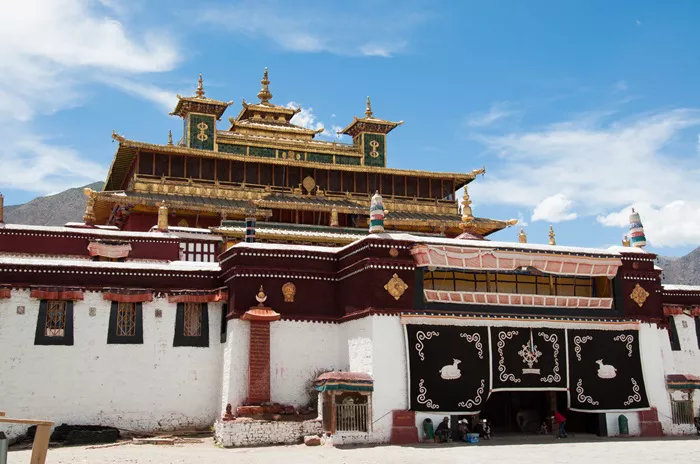Samye Monastery is one of the most important Buddhist sites in Tibet. It is known as the first Buddhist monastery built in Tibet, marking a key moment in the history of Tibetan Buddhism. The monastery holds deep spiritual and cultural significance. It symbolizes the introduction and establishment of Buddhism in Tibet.
Founded in the 8th century, Samye Monastery became a center for Buddhist learning and practice. Its unique design and temple architecture reflect a blend of Indian, Tibetan, and Chinese influences. Understanding Samye gives insight into the early development of Tibetan Buddhism and its rich traditions.
The Historical Background of Samye Monastery
Founding of Samye
The monastery was built during the reign of King Trisong Detsen, who ruled Tibet in the 8th century. He invited the great Indian Buddhist master Padmasambhava to Tibet. Padmasambhava is credited with taming local spirits and spreading Buddhist teachings. The construction of Samye Monastery began around 779 CE under his guidance.
Significance in Tibetan Buddhism
Samye was the first Buddhist monastery established in Tibet. Before its construction, Buddhism was still new and not well organized in the region. Samye became the main center for Buddhist study, meditation, and rituals. Monks gathered here to translate Buddhist scriptures and teach Dharma. This helped Buddhism to firmly root itself in Tibetan culture.
The Role of Indian Masters
Samye also symbolizes the connection between Indian and Tibetan Buddhism. Indian scholars and monks played a major role in shaping Tibetan Buddhism’s early form. The monastery became a bridge linking Indian Buddhist philosophy with Tibetan spiritual traditions.
Architectural Layout and Style of Samye Monastery
The Symbolic Design
Samye Monastery’s layout is carefully designed to represent the Buddhist universe. It follows a mandala pattern, which is a spiritual and ritual symbol in Buddhism. The monastery is arranged in a square shape, representing the earth, with a central temple symbolizing Mount Meru, the mythical mountain at the center of the universe in Buddhist cosmology.
The Central Temple
The main temple at Samye is the heart of the monastery. It houses many sacred statues and paintings. The architecture combines Indian, Chinese, and Tibetan styles, showcasing early influences on Tibetan buddhist architecture. The walls and ceilings are richly decorated with murals illustrating important Buddhist stories and teachings.
The Four Surrounding Temples
Around the central temple are four smaller temples, each representing one of the four continents described in Buddhist cosmology. These temples are aligned in the cardinal directions: north, south, east, and west. This arrangement symbolizes the spread of Buddhism to all parts of the world.
The Outer Structures
The monastery complex includes living quarters for monks, study halls, and meditation rooms. The buildings are connected by courtyards and pathways, creating a peaceful environment for spiritual practice.
Religious Practices and Traditions at Samye
Monastic Life
Monks at Samye Monastery follow strict daily routines. They practice meditation, chant sutras, and study Buddhist philosophy. The monastery is a living center of Buddhist education, where monks learn Tibetan language, logic, debate, and ritual arts.
Festivals and Rituals
Samye hosts important religious festivals throughout the year. These events include ceremonies to honor Padmasambhava and other Buddhist figures. Ritual dances, prayers, and offerings are common during these festivals. They attract pilgrims from all over Tibet and beyond.
Role in Tibetan Buddhism Today
Though Samye has faced damage and restoration over centuries, it remains a vital spiritual hub. Many Tibetan Buddhist schools trace their roots to the teachings spread from Samye. It continues to inspire practitioners with its deep history and sacred atmosphere.
Samye Monastery and Tibetan Culture
Cultural Influence
Samye Monastery is not only a religious site but also a cultural landmark. It played a key role in shaping Tibetan art, literature, and religious customs. The monastery’s murals and statues are masterpieces of Tibetan craftsmanship.
Preservation Efforts
In modern times, there have been efforts to preserve and restore Samye Monastery. Protecting this heritage site ensures that future generations can learn from and experience its spiritual richness.
Visiting Samye Monastery
Location and Accessibility
Samye Monastery is located in the Lhoka region of Tibet, about 110 kilometers southeast of Lhasa. It sits near the Yarlung River in a peaceful valley surrounded by mountains. Visitors often travel from Lhasa by road to reach the monastery.
What to Expect
Visitors to Samye can explore the main temple and surrounding buildings. The monastery offers a glimpse into Tibetan monastic life and ancient Buddhist traditions. The tranquil environment encourages reflection and meditation.
Respectful Behavior
When visiting, it is important to respect local customs. Dress modestly, speak quietly, and ask permission before taking photos inside the temple. Observing proper etiquette honors the sacredness of the place.
Conclusion
Samye Monastery stands as a symbol of the birth and growth of Buddhism in Tibet. Its unique buddhist temples and architecture tell the story of a spiritual tradition that has deeply influenced Tibetan society and culture. More than a thousand years later, Samye remains a beacon of Buddhist faith and practice.
By understanding Samye Monastery, one gains not only historical knowledge but also a deeper appreciation of the spiritual heritage that continues to inspire millions around the world.

